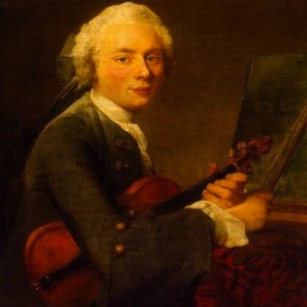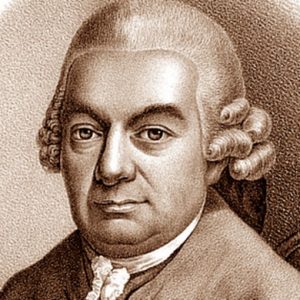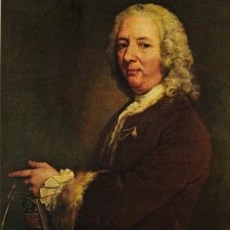by Sallynee Amawat (Infusion Baroque)
When we reflect on composers of the distant past, our first thought is usually of their music: the glorious strains of a Bach suite, the virtuosity of a Leclair sonata, or the brilliance of Telemann’s concertos. In contrast to the general gossip we hear about popular music and film artists of today, we know relatively little of the personal lives of these great masters. In “Rebels and Rivalries”, Infusion Baroque investigates the dark side of beloved eighteenth-century composers, exposing the personal conflicts, scandals, and rivalries that also shaped their musical lives.

Jean-Marie Leclair (1697–1764) and Jean-Pierre Guignon (1702–1774) were highly esteemed violinist-composers in Paris during the early eighteenth century. Both were students of Giovanni Battista Somis (1686–1763) and proponents of the Italian violin school. In 1733 they found themselves bitter rivals when Louis XV appointed them both to the ordinaire de la musique du roy. Leclair and Guignon each coveted the position of first violin, and eventually a deal was struck in which they would rotate the position on a monthly basis. Leclair took first rotation but after his first month was up, he chose to resign and leave Paris rather than play second violin to Guignon. The chamber works by these two composers also reflect the rivalry that raged in Paris between the Italian and French styles during this period. Italian music gained favor with French audiences thanks to its promotion by the Concert spirituel, but musical conservatives resisted its influence. Much of Leclair’s music is Italianate; however his Deuxième récréation de musique pays homage to the traditional French dance suite. Meanwhile Guignon, a native of Italy who became a French citizen, begins his trio with three movements in the Italianate style, but transitions to movements decidedly French, concluding with a Chaconne that bears a striking resemblance to that of his rival, Leclair.
The venerable Johann Sebastian Bach (1685–1750) was a formidable musical force during his lifetime and regarded by later generations as the greatest of German baroque composers. Sebastian’s reputation as a teacher was likewise impressive, if somewhat authoritarian. One famous anecdote from his early years as a teacher describes Bach getting into a brawl with one of his students. At a chance meeting at an outdoor market, the student, a bassoonist by the name of Geyserbach, confronted Sebastian regarding a criticism he had made about the former’s playing. The two exchanged heated words and Sebastian even drew his sword! Fortunately the altercation was dissolved before any bloodshed occurred; Bach was later found guilty of instigating the argument by calling Geyserbach a “nanny-goat bassoonist.”
Wilhelm Friedemann Bach (1710–1784) and Carl Philipp Emanuel Bach (1714–1788) were the two eldest sons of Johann Sebastien Bach, and his only surviving sons from his first marriage to Maria Barbara Bach. Both received their musical training from their father and had to contend with each other and with their father’s reputation all their lives. The elder son Friedemann was a brilliant improviser and keyboard virtuoso, and there is evidence that he may have been his father’s favorite. Sebastien Bach wrote many manuscripts, compositions and tutorials explicitly for Friedemann, and at the age of fifteen sent him to study with the celebrated violinist Johann Gottlieb Graun. Perhaps intimidated by his father’s mastery, Friedemann focused more on building his reputation as a virtuoso soloist than on composition; he is often portrayed as an underachiever in his later musical career and wrote many fewer pieces than his father and brother. Nevertheless, his compositions exhibit a strongly individual and original style and he is still considered a key composer in the transition from the baroque to the Classical period. His keyboard works, including the Fantasias, are quite idiosyncratic and reflect his penchant for virtuosity and improvisation.

Emanuel was more successful than his older brother in his professional career, and also more famous than his father in his own lifetime. When Haydn, Mozart, and Beethoven referred to Bach in their writings, they meant C.P.E. rather than J.S.! Emanuel was responsible for publishing many of his father’s works and spoke reverently of Sebastian’s music in his own writings; however, his letters evince a strong desire to find his own musical voice and to distance himself from his father’s legacy. In fact, Emanuel was a highly original composer and performer in his own right and very little of Sebastian can be seen in Emanuel’s own works, which tend toward the early classical gallant style and the “Sturm und Drang” movement of the late eighteenth century. His trio in C-major is an example of his early style, and among those that he revised in 1747; the earlier version was most likely drafted in 1731 while he was a student in Leipzig.
Godfather to C.P.E. Bach, Georg Philipp Telemann (1681–1767) was the most prolific composer of the baroque period. His works are diverse and delightful, earning praise from both his fellow composers and from the public. Georg Friedrich Handel, a close friend and colleague, once declared that Telemann could write an eight-part motet as easily as one could write a letter! However, in contrast to Bach’s sons, Telemann’s musical aspirations were not supported by his family, despite his compositional prowess and mastery of several instruments at an early age. Born to parents with strong ties to the Lutheran church, Telemann’s mother strongly disapproved of music and insisted that Telemann study law when he entered Leipzig University in 1701. However, within a year of starting his studies Telemann founded a student Collegium Musicum; within two years he was musical director of the Leipzig Opera and fully embarked on a career in music, despite his mother’s wishes. His quartets for flute, violin, cello and continuo were lauded by Parisian audiences for their balance of Italian and French aesthetics.

Francesco Geminiani (1687–1762) had a long and successful career as a virtuoso violinist, composer and theorist, particularly in London where his popularity was due in part to the English obsession with Italian music. His reputation in England paralleled that of Handel and Corelli, but his ideas often diverged from those of his contemporaries. His decision to leave Italy for London was prompted by a humiliating experience in Naples, where he was demoted from concertmaster due to his inability to play with steady rhythm. Charles Burney commented that, “he was so wild and unsteady a timist that instead of regulating and conducting the band, he threw it into confusion.” Indeed, Geminiani’s music was often criticized for its melodic and rhythmic irregularities. In his The Art of Playing the Violin (1751), he advised against the “wretched Rule of drawing the Bow down at the first Note of every Bar,” systemized by the French in order to help keep time in dance music. Regarding the use of vibrato, Geminiani recommended to use it “as often as possible” in his Treatise of Good Taste in the Art of Musick (1749), contrary to other writers such as Leopold Mozart, who considered the use of vibrato to be ornamental. The Scottish tune “The Broom of Cowdenknows” was included in his Treatise of Good Taste where he attributed (scholars say spuriously) it to David Rizzio. While Geminiani was an admirer of Rizzio as a composer of melodies, he claimed that “Melody, tho’ pleasing to All, seldom communicates the highest Degree of Pleasure,” and thereby composed an arrangement of three parts, thus giving it “all the Variety and Fullness required in a Concert.”
Another virtuoso violinist who enjoyed immense fame in London was the German-born Thomas Baltzar (1631–1663). After seeing him perform, one observer wrote, he “plaid on that single instrument a full Consort, so as the rest, flung-downe their instruments, as acknowledging a victory.” The divisions on John, come kiss me now, published in Playford’s The Division Violin (1684), are supposedly a transcription of a competition at Oxford in 1658 between Baltzar and the English violinist David Mell. While Mell was noted to have played “farr sweeter,” Baltzar’s hand “was more quick and could run to the end of the finger-board.” Our arrangement, performed on violin and recorder, combines both the Mell and Baltzar versions.












